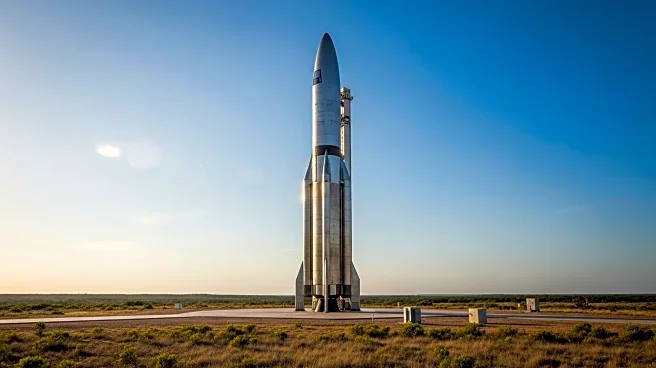What is the story about?
What's Happening?
SpaceX is set to launch its Starship Flight 11 megarocket on October 13, 2025, from its Starbase site in South Texas. The launch window opens at 7:15 p.m. EDT, and the event will be streamed live. Starship, the largest and most powerful rocket ever built, consists of a first-stage booster called Super Heavy and an upper-stage spacecraft known as Starship. Both components are designed for full and rapid reusability. The test flight aims to replicate the success of Flight 10, which saw the Super Heavy booster splash down in the Gulf of Mexico and the Starship in the Indian Ocean. Flight 11 will test a new landing burn engine configuration for Super Heavy and gather data to enable future missions to end with a return to Starbase, where the launch tower's 'chopstick' arms will catch the spacecraft.
Why It's Important?
The successful launch and testing of SpaceX's Starship Flight 11 are crucial for advancing the company's goal of making space travel more sustainable and cost-effective through reusability. This test is part of SpaceX's broader vision to enable human settlement on Mars, a long-held ambition of CEO Elon Musk. The new landing configuration and stress-testing of the vehicle's tiles are significant steps toward ensuring the spacecraft's durability and reliability for future missions. The data collected from this flight will inform improvements in guidance algorithms and landing techniques, potentially revolutionizing space travel and exploration.
What's Next?
Following the test flight, SpaceX will analyze the data collected to refine its landing techniques and vehicle design. The company plans to continue testing and improving the Starship's capabilities, with the ultimate goal of achieving a successful return to Starbase. This involves perfecting the dynamic banking maneuver and subsonic guidance algorithms. Future missions will focus on increasing payload capacity and reliability, paving the way for more ambitious projects, including interplanetary travel and Mars colonization.
Beyond the Headlines
The development of reusable spacecraft like Starship could have profound implications for the space industry, reducing costs and increasing accessibility for scientific research and commercial ventures. The ethical and cultural dimensions of space colonization, such as the impact on human society and the environment, will become increasingly relevant as SpaceX progresses toward its Mars settlement goals. These developments may also influence international space policy and collaboration.
AI Generated Content
Do you find this article useful?














